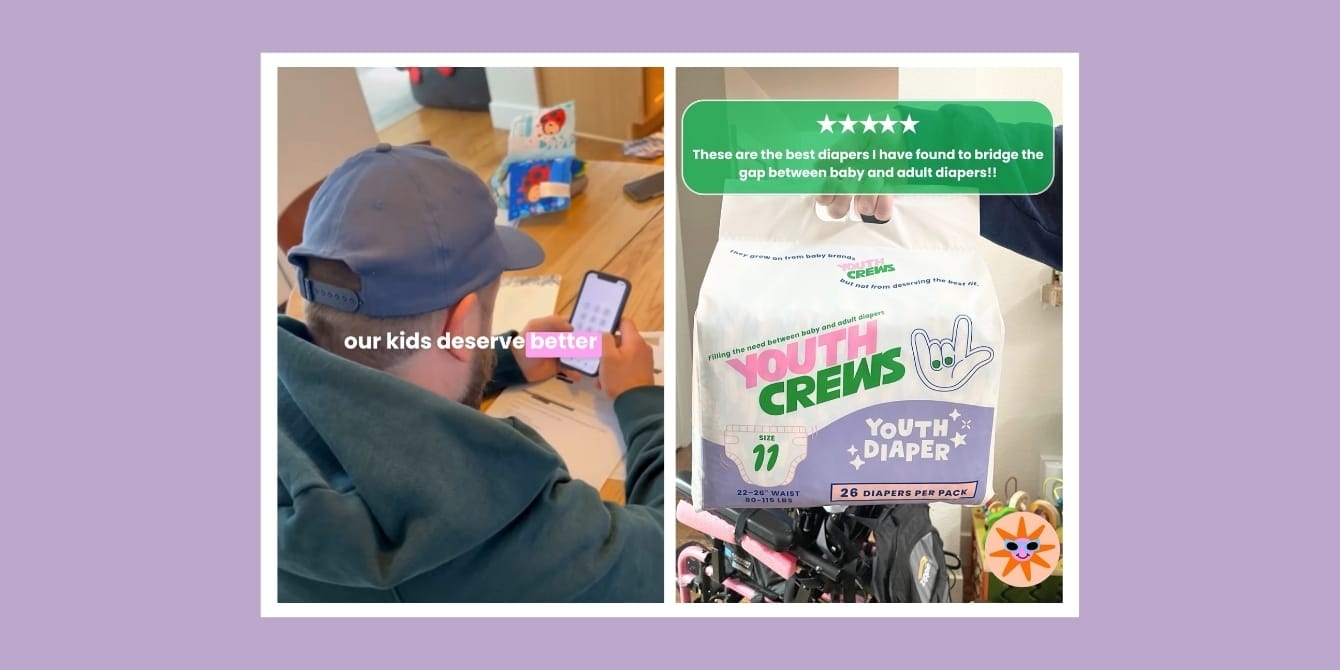What it reveals about how the system continues to fail kids with disabilities—and how parents are stepping up
When Brady Crandall’s daughter was born with a brain injury called hypoxic-ischemic encephalopathy (HIE), he never expected he’d one day be founding a diaper company. But when she began to outgrow traditional baby diapers, he realized a troubling gap in the market: there were no age-appropriate diapering solutions for kids like her—children with disabilities who aren’t ready for adult products, yet have long outgrown baby sizes.
It’s the kind of problem you don’t see—until you’re living it.
Most brands cap out at size 6 or 7. Crandall’s company, Youth Crews, fills the void with sizes 9, 10, and 11—made just for growing kids who still need high-absorbency, well-fitting diapers to live comfortably, confidently, and with dignity.
Related: My mental health as a parent of a child with a disability
A missing product—or a missing priority?
The issue isn’t just sizing. It’s systemic. Across the board—from healthcare access to public spaces to everyday products—the disability community is often treated as an afterthought. And when the burden falls on parents to create the resources that should already exist, it highlights how deeply underserved this population remains.
“Our kids aren’t wearing onesies anymore,” Crandall explains in an interview to Parents. “They’re wearing jeans, real clothes. They go to school, they socialize. They deserve products that respect that.”
For children who use wheelchairs or mobility aids, the wrong diaper isn’t just inconvenient—it can disrupt their day, damage equipment, or even cause health issues. This is about more than comfort. It’s about access, dignity, and inclusion.
When the system doesn’t step up, parents do
Youth Crews launched in December and has already shipped over 2,300 orders. Crandall says the response has been overwhelming—not just from a demand perspective, but from the emotional feedback.
“Parents have sent us notes saying it’s the first diaper to fit their child in over 15 years,” he says. “We’ve received thank-you messages that make you cry. It’s humbling.”
His journey was powered by persistence, community, and—most importantly—support from his wife. As full-time in-home caregivers in Colorado, the couple balances work, care, and entrepreneurship. Crandall, who has a background in advertising, teamed up with a former mentor to build the company from the ground up—learning about manufacturing, distribution, and everything in between.
More than just a product
The Youth Crews packaging is another subtle but meaningful shift. There are no pastel baby animals or infant imagery—just age-appropriate, empowering visuals that reflect the kids who use them. And for families who spend so much of their lives navigating inaccessible systems, that representation matters.
“Even just seeing the Youth Crews package in her room feels better,” Crandall says. “It’s small, but it’s something.”
Youth Crews currently accepts FSA/HSA payments and is exploring options to make the products more accessible financially, including working with advocacy organizations and exploring potential insurance partnerships.
A community, not a customer base
This isn’t just a company—it’s a community movement. It’s a reminder that every product we take for granted was designed with someone in mind—and often, it wasn’t a child with disabilities. When that’s your reality, parenting becomes advocacy by default.
But thanks to stories like Crandall’s, things are starting to shift.
“People travel the world looking for peace,” he says. “But when you have a child with disabilities, you learn how to find contentment in the simplest moments.”
In the absence of structural support, it’s often parents who roll up their sleeves and build the world their kids deserve. Youth Crews is just one example—but it’s a powerful one.
Related: My child’s disability does not define him—or me

